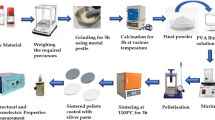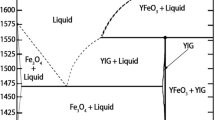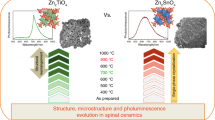Abstract
A method of core–shell-like gradient permeation of Er3+ on the surface of grain was used to prepare xEr3+-Bi0.5Na0.5TiO3 ceramics. The structure and photoluminescence properties were investigated both on the gradient and homogenous doping. The XRD patterns exhibited a single rhombohedra phase. The photoluminescence measurements showed a maximum value at x = 1.5 wt% for the gradient xEr3+-Bi0.5Na0.5TiO3 ceramics, and a maximum value at x = 2.0 wt% for the homogenous one, also critical concentrations of elimination of segregation of large strip grains. Significantly, an enhanced efficiency of bright green emission at about 550 nm was observed in the gradient Er3+-Bi0.5Na0.5TiO3 ceramics. In structure a critical concentration of elimination of segregation of large strip grains corresponds to the highest PL peak. The possible mechanism was discussed that concentration quenching effect is supposed due to the degeneration effect of multi-rare earth ions to allow energy transfer accompany with non-radiative loss. Gradient concentration will cause gradient overlapping energy levels to restrict energy transfer to enhance luminescence effect.





Similar content being viewed by others
References
Z.G. Lu, Y.G. Tang, L.M. Chen, Y.D. Li, Shape-controlled synthesis and characterization of BaZrO3 microcrystals. J. Cryst. Growth 266, 539–544 (2004)
Q. Zhang, H. Sun, X. Wang, Y. Zhang, X. Li, Strong photoluminescence and piezoelectricity properties in Pr-doped Ba(Zr0.2Ti0.8)O3–(Ba0.7Ca0.3)TiO3 ceramics: Influence of concentration and microstructure. J. Eur. Ceram. Soc. 34, 1439–1444 (2014)
P. Du, L. Luo, W. Li, Y. Zhang, H. Chen, Electrical and luminescence properties of Er-doped Bi0.5Na0.5TiO3 ceramics. Mater. Sci. Eng. B 178, 1219–1223 (2013)
H. Sun, Q. Zhang, X. Wang, T. Zhang, Bi0.5Na0.5TiO3:Eu3+: an intense blue converting red phosphor. Mater. Lett. 131, 164–166 (2014)
T. Wei, F.C. Sun, C.Z. Zhao, C.P. Li, M. Yang, Y.Q. Wang, Photoluminescence properties in Sm doped Bi1/2Na1/2TiO3 ferroelectric ceramics. Ceram. Int. 39, 9823–9828 (2013)
M.G. Ha, M.R. Byeon, T.E. Hong, J.S. Bae, Y. Kim, S. Park, H.-S. Yang, K.S. Hong, Sm3+-doped CaTiO3 phosphor: Synthesis, structure, and photoluminescent properties. Ceram. Int. 38, 1365–1370 (2012)
D. Peng, H. Sun, X. Wang, J. Zhang, M. Tang, X. Yao, Red emission in Pr doped CaBi4Ti4O15 ferroelectric ceramics. Mater. Sci. Eng. B 176, 1513–1516 (2011)
T. Wei, Z. Chang, Q.J. Zhou, D.M. An, Z.P. Li, F.C. Sun, Bright green emission in Ho doped Bi1/2Na1/2TiO3 ferroelectric ceramics. Mater. Lett. 115, 129–131 (2014)
T. Wei, Q.J. Zhou, C.Z. Zhao, Y.B. Lin, Y.L. Zou, Y. Li, L.S. Zhang, Strong green light emission in Ho doped Bi4Ti3O12 ferroelectric ceramics. Ceram. Int. 39, 7211–7215 (2013)
M. Zannen, A. Lahmar, M. Dietze, H. Khemakhem, A. Kabadou, M. Es-Souni, Structural, optical, and electrical properties of Nd-doped Na0.5Bi0.5TiO3. Mater. Chem. Phys. 134, 829–833 (2012)
F. Benz, H,P. Strunk, Rare earth luminescence: a way to overcome concentration quenching. AIP Adv. 2, 042115 (2012)
F. Benz, M. Yang, Y. Weng, H.P. Strunk, Luminescence intensity and dopant concentration in AlN:Tb. J. Lumin. 132, 1493–1496 (2012)
C.Y. Chang, W.N. Wang, C.Y. Huang, Effect of MgO and Y2O3 doping on the formation of core–shell structure in BaTiO3 ceramics. J. Am. Ceram. Soc. 96, 2570–2576 (2013)
H.Y. Chang, S.Y. Cheng, C.I. Sheu, Controlling interface characteristics by adjusting core–shell structure. Acta Mater. 52, 5389–5396 (2004)
C. Fang, D.X. Zhou, S.P. Gong, Core–shell structure and size effect in barium titanate nanoparticle. Phys. B-Condens. Matter 406, 1317–1322 (2011)
S.C. Jeon, C.S. Lee, S.J.L. Kang, The mechanism of core/shell structure formation during sintering of BaTiO3-based ceramics. J. Am. Ceram. Soc. 95, 2435–2438 (2012)
Z. Xu, S. Ma, R. Chu, J. Hao, L. Cheng, Guorong Li, Low-temperature sintering of high potential gradient B2O3-doped in ZnO varistors. J. Mater. Sci: Mater. Electron. 26, 4997–5000 (2015)
Y.X. Chen, B.N. Liu, Y. Ma, Y.C. Zhou, Modification of a shell model for the study of the radiation effects in BaTiO3, nuclear instruments and methods in physics research section B-beam interactions with materials and atoms, 267 (2009) 3090–3093
W.Q. Cao, F.L. Li, M.M. Ismail, G. Xiong, Dielectric properties of Y2O3 and Nb2O5 Co-doped barium titanate ceramics. Jpn. J. App. Phys. 51, 041503 (2012)
Author information
Authors and Affiliations
Corresponding author
Rights and permissions
About this article
Cite this article
Cao, W.Q., Wang, R.L., Zhou, F.L. et al. Enhance luminescence property of Er in Bi0.5Na0.5TiO3 ceramics by gradient permeation method. Appl. Phys. A 123, 693 (2017). https://doi.org/10.1007/s00339-017-1298-2
Received:
Accepted:
Published:
DOI: https://doi.org/10.1007/s00339-017-1298-2




